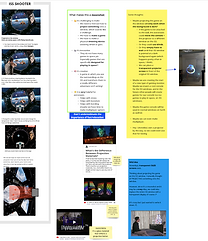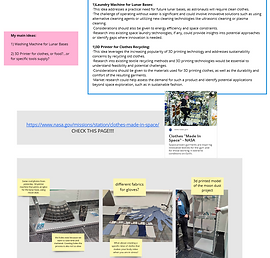Who We Are
At Media Techstronauts, we are a team of Leiden University students participating in the NL MOONSHOTS '24 project. Our goal is to share our journey and progress through our one pager. Our one pager showcases our innovative ideas. We invite you to join the discussion and be part of our mission.









Process
We have been using Miro for brainstorming, sketching and saving our ideas and insights.
We want to make something that meets the following criteria:
Innovative
Creative
Challenging
Valuable
The moonshot
overview
Our project aims to create a game specifically tailored for astronauts in space to assist with their relaxation. Astronauts can feel very isolated in space which possibly leads to stress and anxiety, fatigue, sleep problems, irritability, mood swings, negative emotions, and emotional distress [1][2]. Providing a new form of entertainment and relaxation might therefore help improve their mental health [3]. The concept involves projecting an interactive game onto the window(s) of the cupola, merging interactive gameplay with the view of space. This venture will explore various game types, interaction methods, suitable controllers, and the most effective projection techniques. Additionally, the integration of real space data will enhance the experience. This makes it even more based on reality, besides the fact that the view through the actual window will also be used.


Game Genre
We are in the exploratory phase regarding the game’s genre, aiming to find the best fit for astronauts’ needs and preferences. This is crucial for creating an engaging and enjoyable experience that can adapt to the unique environment of space, considering factors such as microgravity and the limited physical space available. We want to ensure the final game will provide meaningful relaxation and entertainment for the crew aboard the International Space Station (ISS).
Additionally, to combat isolation and foster connections with others, we are considering the implementation of multiplayer modes. These modes could allow astronauts to play with each other or with loved ones on Earth. With this, we want to create a sense of closeness and shared experiences.
Controller Selection
The right controller is crucial in the space station’s environment. We’re evaluating options from traditional hand-held to gesture-based systems. So far, we looked into controlling the game with gestures, pointers (such as a Wii controller), traditional controllers, and gloves with sensors. The focus lies on comfort, ease of use and functionality in zero gravity. Therefore, we came to the conclusion that using a simple arcade joystick would be the easiest and most straightforward controller to use.

Example of a mounted controller

Example of a hand-held laser gun controller
Integration of Real Space Data
A remarkable feature of the game could be the use of real space data to enrich the gameplay. By incorporating, for example, space weather, debris and meteoroids information, or other relevant data, the game will connect players with the reality of space exploration. This approach will connect players with the dynamic aspects of space navigation and situational awareness, providing a more realistic and engaging backdrop for the game. By using this type of data, the game not only becomes a source of entertainment but also serves an educational purpose, enhancing players’ knowledge and understanding of the challenges faced in space exploration.
The different challenges that surface when trying to project the game on the window of the cupola are mentioned below. Additionally, multiple solutions are listed. The solution we decided to go for, is using AR glasses. The environment of the game (the space setting) would still be the actual space environment the player is in when looking through the window of the cupola. However, instead of projecting the game on the windows, the game will be visible through the AR glasses. AR transforms the cupola window into spaceship with meteors flying around. It will show the game interface exclusively when looking at the cupola window.
A final prototype for the computer can be seen in the video on the right. This prototype was built in Unity with inspiration from an online tutorial for the environment. All the different game elements were implemented by ourselves. The astroids were made in Blender.


Display Strategy and Game Development
Using tools like Blender, and Unity we plan to create an engaging environment within the space constraints that merges technological innovation with the unique space setting. Our plan includes projecting the game onto the cupola’s windows on the ISS, potentially using either the central window or all seven for a panoramic experience.
Projecting Challenges and Solutions
Projecting the game onto the central window (or all windows) of the cupola presents unique challenges, especially due to the microgravity environment of ISS and the nature of the window itself. We anticipate difficulties with light backgrounds. For example, when the window faces Earth, as the light from Earth could overpower the projection. Additionally, the effectiveness of projecting onto a standard glass window is uncertain since none of us have prior experience with such a setup in space. There’s a possibility that a regular glass window may not reflect projections adequately. Moreover, determining an optimal location for the projector is crucial. The projector must be positioned in a way that it remains static, and astronauts should not obstruct the projection by floating or standing in front of it.
To address these challenges, we are considering several techniques:
-
Testing the projection on a standard window. If this only seems to work with a dark background, the game might only be possible to play when the cupola offers a view of the darker aspects of space.
-
Exploring the use of special glass embedded with materials that enhance projection visibility.
-
Considering the use of a transparent projector screen. Placing a transparent projector screen in front of the original ISS window.
-
Investigating solutions like an “invisible TV”. Nowadays, transparent OLED screens exist. Other possible solutions are INVISCREEN or Diamond Coatings Anti-Reflective Glass. This could offer the possibility of integrating high-definition displays without obstructing the view of space.
-
Considering projecting onto the backside of the glass or projector screen, which would require some distance between the window and the game screen to ensure clear visibility and prevent any interference.
-
Using AR glasses instead of an actual projection on the window. The AR glasses should then be activated when looking at the circular winfow of the cupola. When not looking at this window, the AR glasses should not show anything of the game.

Something we place in front of the window...
Transparent projector screen

(Nearly) transparent projection film which you stick onto the windows, that reflects projections better

This type of glass reduces reflections, so you don't see your own reflection. Common in museums and AR devices.
Anti-reflective glass

This could be a moonshot on its own... We could replace the entire window with a:
Transparent OLED display
What Makes This a Moonshot?

(S}TECH
This project stands out as a moonshot for several reasons:
01
It’s Challenging
We’re tackling the unique challenge of projecting a game onto a spacecraft window and developing a game that astronauts can enjoy in space. On top of that, we are also looking into the most effective way to control the game.
03
It’s Innovative
There aren’t many games designed for space, making our project a pioneer in space entertainment.
02
It’s Creative
The game transforms the ISS surroundings into an adventurous sci-fi setting, offering a new way to experience the space environment.
04
It Benefits Astronauts
It is designed to reduce stress and boredom and could potentially include a multiplayer option to improve bonding among astronauts.

Purpose.
The ultimate goal of this project is to enhance the mental health and well-being of astronauts by providing them with a novel form of relaxation and entertainment. Through innovative design, meaningful content, and interactive experiences, we aim to mitigate the feelings of isolation experienced in space. Hopefully, contributing positively to the astronauts’ overall mission success and quality of life.
